Key Insights
- The introduction of the V3 Governance Module (V3GM) marks another evolution of Synthetix’s governance structure and on-chain voting on the Layer-2 (L2) Optimism.
- Over the past year, many Synthetix governance proposals focused on building out the Synthetix suite of revenue-driven products, i.e., atomic swaps and perpetual futures.
- Synthetix governance communications could be improved to potentially enhance the quality of decisions and accountability of council members.
Background
In 2018, Synthetix elected to decommission the Synthetix Foundation, a not-for-profit foundation based in Australia, in favor of decentralizing its governance.
Synthetix’s goal in shifting to a decentralized governance model was to reduce the required trust in the core team and create a censorship-resistant protocol to exchange synthetic assets by building a trustless, permissionless, and immutable protocol. Synthetix Founder Kain Warwick’s initial governance vision did not include on-chain governance due to it being “fundamentally flawed.” Warwick argued that on-chain governance created a greater project risk to Synthetix than the possibility of the Synthetix Foundation being captured by a bad actor.
In July 2020, Synthetix fully transitioned from a foundation to a DAO composed of three subDAOs:
- protocolDAO was responsible for protocol upgrades and variable configurations.
- grantsDAO was responsible for funding public goods in the Synthetix ecosystem.
- synthetixDAO was responsible for managing and deploying funds to contributors and other project needs.
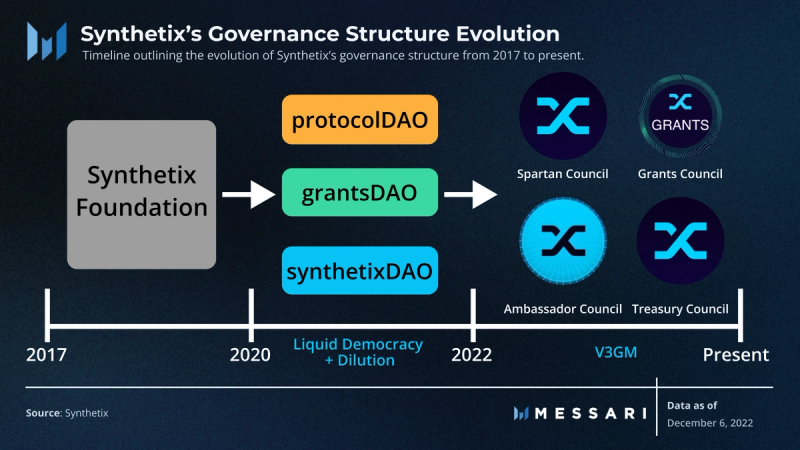
Governance Overview
Synthetix governance has been through multiple iterations, including the formation of liquid democracy and the dilution of voting power, before the V3 Governance Module (V3GM) introduction in June 2022. SIP 207: V3GM outlines Synthetix’s latest governance iteration and updating its council-based governance structure to four councils and one committee.
Council-based governance is an alternative to the primary governance models of token-weighted and delegated governance. It leans more towards traditional governance models, such as representative democracy and a board of directors. By depending on fewer people with an equal voting power to make decisions, council-based governance seeks to address the shortcomings of its counterparts. Token-weighted and delegated governance often result in voter apathy and a large voting power concentration. To elect council members within the DAO, Synthetix uses a quadratic voting model.
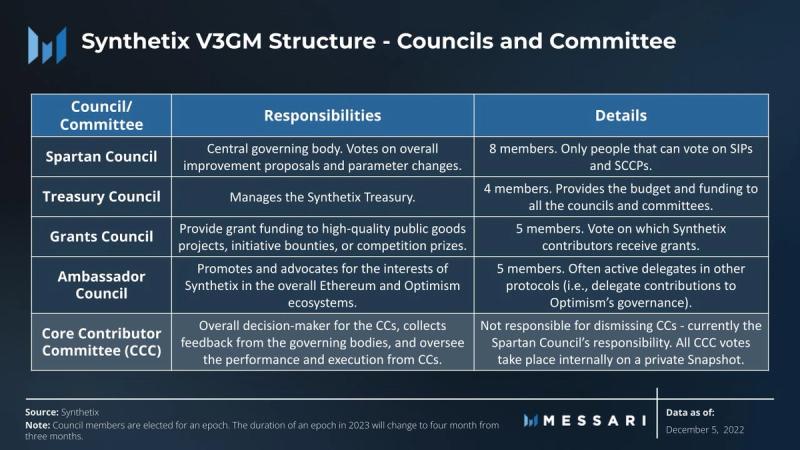
V3GM
With the V3GM model, all council nominations and elections move from an off-chain process on Snapshot to the on-chain Election Module on Optimism. Among many benefits, the transition to on-chain Council elections has increased Synthetix’s decentralization by mitigating the possibility of human interference. The protocolDAO is no longer required to execute off-chain election results and manually transfer the Council NFT to the elected members. Instead, elections will now be conducted on-chain.
The key considerations Synthetix made when designing V3GM was to optimize for low-cost elections and avoid having signers for the DAO’s multi-sig where tokenholders have no recourse to remove the signers. Thus, Synthetix Core Contributors chose Optimism as a Layer-2 (L2) network to optimize for low-cost gas fees and an inclusive on-chain elections voting process. Since there is a large pool of Synthetix voters on Ethereum Layer-1 (L1), V3GM has an intermediary solution that uses a Merkle tree snapshot of L1 debt holders and uploads it into the Optimism L2 instance. This intermediary solution will be replaced once the V2.X debt migration happens.
The on-chain Election Module has brought a new voting strategy to Synthetix governance:
- The current epoch duration for an elected council member is three months but will change to four months in 2023.
- Eligible voters are debt unit tokenholders who have staked their SNX.
- Nominations and elections happen concurrently during a two-week period.
- Voting power is calculated by the debt share balance.
- One candidate per vote, applying the associated voting power of one voter to the one candidate.
- Voting weight is quadratic, 1 debt unit = sqrt(1) vote, except for the treasury council, which is linear.
- Vote counting is a plurality voting strategy. The candidates with the most voting power will be elected as equal voting members on the respective council.
- The number of elected members:
- Spartan Council: 8
- Grants Council: 5
- Ambassador Council: 5
- Treasury Council: 4
Governance Process
Proposals fall into one of two categories, Synthetix Improvement Proposal (SIP) or Synthetix Configuration Change Proposal (SCCP). SIPs implement core changes to the Synthetix Ecosystem. SCCPs modify system configuration variables. SIPs and SCCPs are only voted on by the eight elected Spartan Council members of the current epoch and must follow the specified Synthetix governance process.


In the Synthetix governance process, there are two types of proposals: governance and meta-governance. The proposal type can be found in the Synthetix Proposal Repository in the table at the top of each SIP and SCCP (i.e., SCCP 300). Governance proposals do not need all eight Spartan Council members to vote for a proposal for it to succeed. Meta-governance proposals require all eight Spartan Council members to vote on the proposal for its success. Meta-governance proposals are for any changes in how governance operates, and governance proposals are for any changes affecting protocol updates.
Governance Impact on SNX
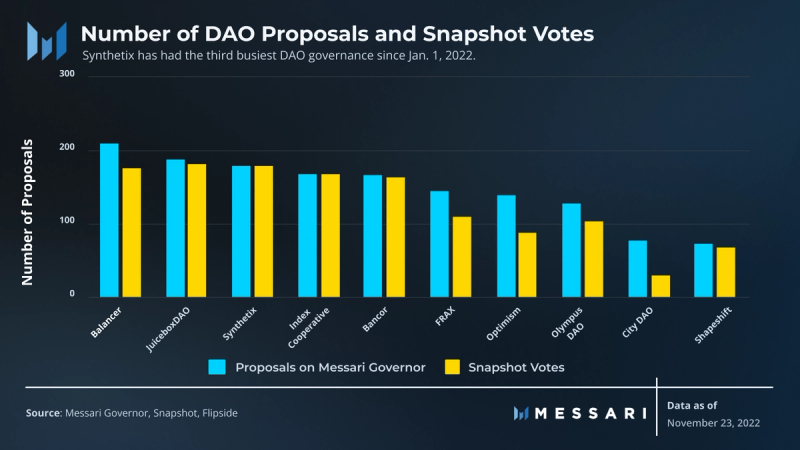
Since Jan. 1, 2022, Synthetix governance has had 168 proposals, making it the third most active DAO that Messari Governor monitors. Most proposals this year have been related to revenue generation, following Warwick’s anticipation of this driving the next DeFi narrative.
Staked SNX Percentage
As discussed in an earlier Synthetix Governor Note, multiple proposals throughout 2022 focused on incentivizing greater staked SNX by implementing unsustainable inflationary SNX rewards. The inflationary SNX rewards introduced in various proposals successfully bootstrapped and secured the network at the expense of creating constant SNX sell pressure. SNX stakers could hedge their exposure by continuously selling their newly unlocked SNX each week.
SIP 276: Turn Off The Money Printer was proposed to cap the total supply of SNX at 300 million and stop the unsustainable inflationary SNX rewards. This effort would ensure that the sUSD fee yield per SNX would grow with the protocol’s revenue, since sUSD rewards are based on the trading fees accrued in the Synthetix ecosystem. However, SIP 276 has not yet moved to a Snapshot vote and is currently in limbo as the SIP 276 author (Warwick) decided not to present it publicly. In addition, the Spartan Council decided SCCP 211 (the proposal to reduce SNX inflation by 5% each week) would be sufficient until new Synthetix products are launched. The discussion to terminate SNX inflationary rewards may be revived once the Spartan Council assesses the impact of the new Synthetix products.
Synthetix initially planned to terminate inflationary SNX rewards in March 2023, which would leave SNX with a total supply of ~250 million. However, the SNX outstanding supply is currently at ~310 million SNX at the time of writing. This effectively makes SIP 276 irrelevant, considering the 300 million SNX circulating has already been surpassed, and ~738,500 inflationary SNX rewards will be distributed the week of Dec. 7, 2022. The number of rewards distributed will continue to decline by 5% each week.
The four proposals that dictated the inflationary rewards were SCCP 196, SIP 202, SCCP 208, and SCCP 211. The initial goal of SCCP 196 and SIP 202 were to hit a targeted staked SNX percentage of 85% to bootstrap and secure Synthetix by increasing the weekly SNX rewards to incentivize more SNX tokenholders to stake their SNX. However, these proposals did not meaningfully impact the staked SNX percentage, and the targeted staked SNX percentage was ultimately lowered to 65%.

If SIP 300 and the other V3-related proposals (SIP 302, SIP 308, and SIP 309) are implemented, multi-collateral staking will be accepted as collateral for the Synthetix debt pool. As a result, the staked SNX percentage metric will be less important in V3. Rather than relying on one form of collateral, V3 will allow Synthetix to be more flexible accept various collateral and provide subsequent liquidity to various markets and financial instruments.
Atomic Swaps
The goal of atomic swaps is to allow decentralized exchange (DEX) aggregators to conduct Synthetix swaps on Ethereum mainnet in an atomic manner (i.e., that they happen in one trade). For example, an atomic swap could look like this ETH <> sETH <> sUSD <> BTC in one swap. The benefits of atomic swaps are less slippage and lower fees.
The Mirarch release implemented SIP 198’s atomic exchange functionality update and introduced latency attacks on the Synthetix protocol via atomic swaps on 1inch and Kwenta. This update led to increased Synthetix trade volume and sUSD trade fee rewards because these latency attacks were bots front-running trades to get the best prices. The results were more profitable trades and, ultimately, significant increases in Synthetix trade volume. These latency attacks only affected Synthetix on Ethereum Mainnet. Trades on Optimism are not subject to latency attacks as there is no 10-minute fee reclamation period given its oracle latency.
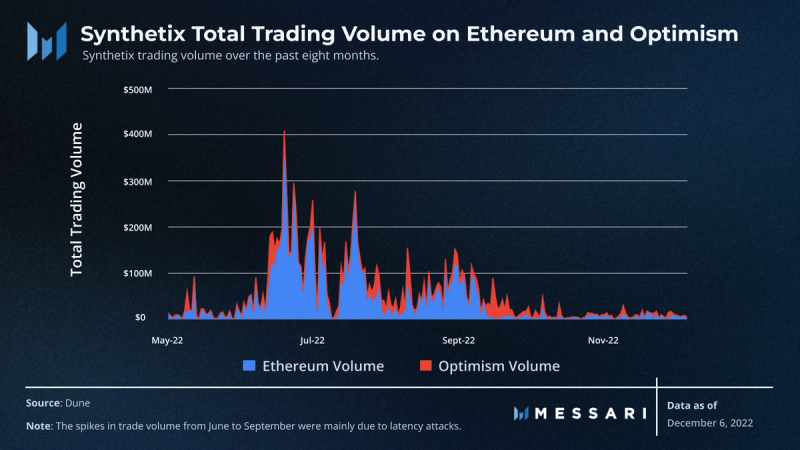
In response to these latency attacks, SIP 267 was introduced to allow the Spartan Council to approve protocols (contracts or externally owned addresses) that wanted to implement atomic swaps. By implementing atomic swaps, protocols were given the ability to interact with Synthetix’s core exchange functionalities and set customized parameters. SIP 267 successfully returned trade volumes and the sUSD trading fee rewards back to healthy levels, alleviating the sell pressure on SNX.
While SIP 267 was successful, the path to success was not so smooth. SCCP 224 failed twice, after aiming to limit latency attacks by lowering the atomic volume per block from 5 to 0.5 million sUSD. This short-term fix was rejected by the Spartan Council, as only 4 votes were cast out of a possible 16 over the two votes, signaling SIP 267 and SIP 288 were the preferred solutions amongst the Spartan Council. The approval and implementation of SIP 267 and SIP 288 (1inch Direct Integration) allow 1inch to include Curve as a path for deep liquidity and less slippage, reducing the likelihood of latency attacks.
The Spartan Council and Synthetix community’s desire to solve the latency attacks demonstrates the sustainable long-term thinking in Synthetix Governance. The net outcome of solving the latency attacks was an improved trading experience (via lower fees and less slippage) in the Synthetix ecosystem. This long-term thinking has also led the Spartan Council to focus on improving another Synthetix product, perpetual futures.
Perpetual Futures
There are three perpetual futures proposals (SIP 279, SIP 280, and SIP 281) in the draft status that aim to upgrade synthetic perpetual futures [V1] to V2. Upgrading the perpetual futures contracts should improve the constrained scalability and efficiency due to the following limitations:
- Capital inefficiency — restrictive open interest limits.
- Funding rate volatility.
- High fees and wide spreads.
These proposals demonstrate that Synthetix aims to be a market leader of perpetual futures on Optimism. If Synthetix continues to capture more perpetual futures market share on Optimism, perpetual futures could become a valuable revenue source for Synthetix.
Communication
The Spartan Council is arguably one of the most transparent DAOs in the space. The Spartan Council members are active in the Synthetix Discord, weekly Spartan Discussions, which are published as podcasts, and SNXweave, a Synthetix grantee that provides weekly recaps of the activity from the four Synthetix Councils via blog and YouTube.
This level of communication is rare within the DAO governance space. Despite Synthetix’s transparency, it is easy to miss new developments and properly gather community sentiment on all proposals due the governance decisions happening on multiple platforms. Without a traditional forum platform, such as Discourse or Commonwealth, it is difficult to research Synthetix governance and to filter for specific topics.
Communication Recommendations
Improving the searchability of Synthetix governance content would alleviate a major pain point for Synthetix community members and might even encourage new Synthetix users to participate in governance. There are several ways Synthetix could improve its content’s searchability.
The recaps by SNXweave are valuable to the Synthetix community, but they sometimes lack the nuance of the detailed discussions between council members on the Spartan Discussion calls. Thus, transcribing the audio from the Spartan Discussions and posting the transcription as a blog would benefit the Synthetix community because it would allow for greater searchability of the Spartan Discussions. If this were implemented, community members could find and discover key governance information about specific proposals.
Discord’s major drawback is that it is difficult to search for historical topics, especially in a very active Discord like Synthetix’s. Using a forum platform like Discourse or Commonwealth to organize all the Synthetix governance-related topics would keep governance topics organized and searchable. While the repository is a good resource, it does not include the community’s feedback on the proposals.
The Synthetix governance documentation is outdated. This is understandable, given Synthetix governance has undergone multiple iterations over the past three years. Nevertheless, it would be very valuable to allocate resources to maintain this documentation in order to minimize confusion for current and future Synthetix community members.
Improved searchability and updated documentation will provide a better user experience for Synthetix community members interested in governance, and it will eliminate the silos that exist today. Improving these two aspects could even increase the number of active governance participants since there will be historical context to help community members understand Synthetix properly. That said, Synthetix is not necessarily incentivized to encourage greater governance participation in Synthetix Governance from the broader Synthetix community, given that only its current council members cast votes. All things considered, when more voices participate in discussions, even if they aren’t voting, the quality of decisions and council members’ accountability increase.
Accountability Analysis
Spartan Council
The Spartan Council has been entrusted by the Synthetix community to be actively involved in making decisions in Synthetix’s best interest. Currently, Synthetix is attempting to balance the protocol’s main objectives of increasing the number of active users and SNX stakers with the goal of creating a revenue-driven, sustainable protocol in a bear market. To do this, all elected council members, including Spartan Council members, are held accountable for providing value to Synthetix. The foundation of providing value to a DAO is showing up and participating. SNXweave has collected council participation data and conducted Team 360 Self Reviews to quantitatively measure council members’ level of participation over the last two epochs.
The Spartan Council meeting and voting participation rates from the Spartan Council members are as follows:
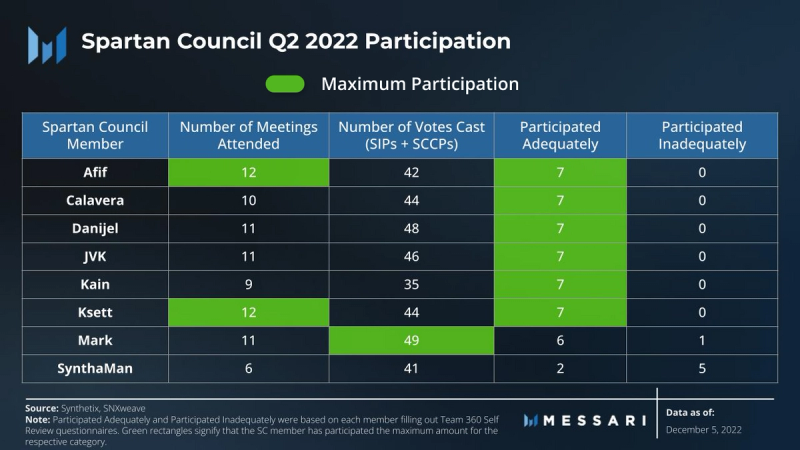
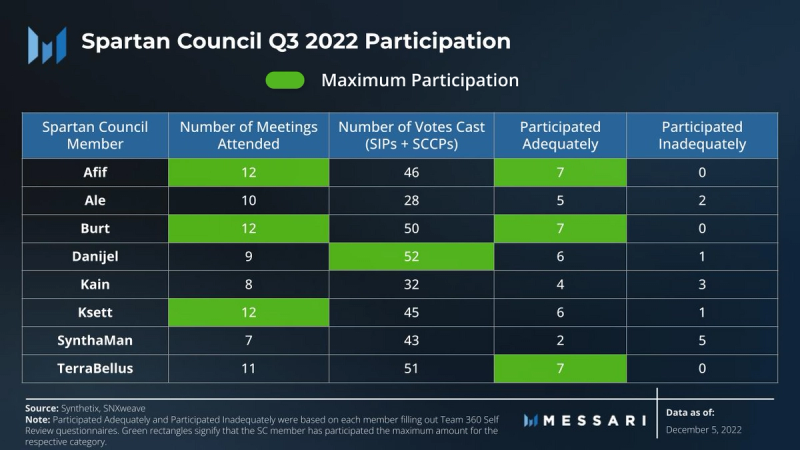
The Spartan Council voting data shows that there were a total of 101 SIPs and SCCPs that went to an off-chain vote during Q2 and Q3 2022. There were also 808 possible votes that could have been cast by the eight Spartan Council members during each epoch. Of these 808 possible votes, 112 votes (13.86%) Spartan Council votes were not cast.
The data collected from the Team 360 Self Review questionnaires is a valuable snapshot of accountability information. This effectively represents how the Spartan Council members felt their Spartan Council peers performed and participated on their behalf throughout the epoch. The Team 360 data displays the effectiveness of each Council member, distilled down to one number. Synthetix voters can use this number to reliably assess each Council member’s commitment.
However, the Team 360 Self Reviews do not come without a few drawbacks, namely:
- The reviews lack context as to why a council member believes another council member has inadequately participated during the epoch without further investigation.
- The reviews open a possible attack vector, allowing council members to provide inaccurate reviews in bad faith. However, there is no evidence or accusations of this happening to date.
Grants Council
The Grants Council’s role in the Synthetix ecosystem is to review grant applications and fund developers who are mission-aligned and willing to grow the Synthetix ecosystem. All grant applications, details, and voting history are provided on the Grants Council’s website. Since Sept. 23, 2021, only 7 of the 68 grant applications have been approved through this grant process.
As mentioned in the Q3 2022 Quarterly Report by SNXweave, grantees have delivered on the following:
- Fee Rebate Initiative — providing OP tokens for referrals and covering trading fees for whale traders to boost Kwenta’s synthetic futures product.
- Explainer Synthetix videos by content creators.
- Wrapper UI.
- New SIP/SCCP submission website with a better user experience so anyone can easily submit a proposal.
- SNXweave—- attendance and participation report and weekly recaps of the Synthetix Councils.
Some other projects that have received grant funding are the NFT Project, HERO stats page, and SNXweave. The HERO stats page would be a welcomed upgrade from the Synthetix community as it aims to address the accuracy issues of Grafana, Synthetix’s current statistics dashboard. However, the subgraph complexities and lack of resources have deemed the HERO stats page no longer viable. The Grants Council has paused all efforts on system-wide statistics until Synthetix transitions to V3.
The goal of the NFT project is to raise funds for liquidity provisioning in the Synthetix ecosystem and for public goods funding to be distributed by the Grants Council. The proceeds raised by the NFT Project will be split 80% going to liquidity provisioning and 20% to public goods funding. Any secondary market royalties will be split with the same ratio.
The Grants Council meeting and voting participation rates from the Grants Council members are as follows:
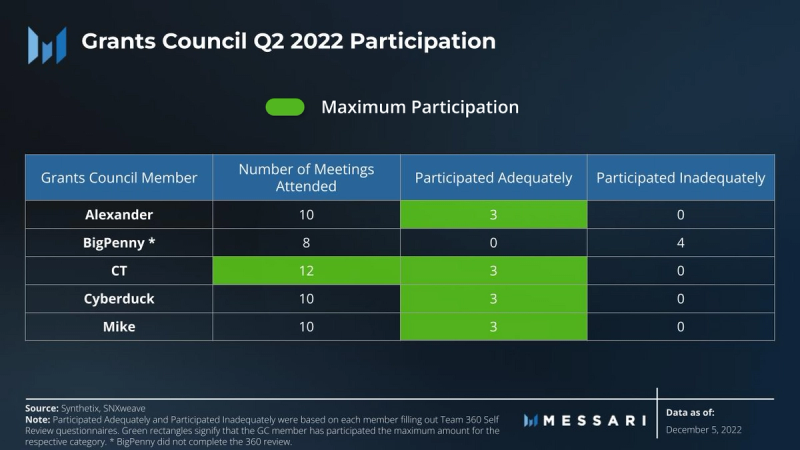

While the Grants Council has clear responsibilities outlined in SIP 141, there are no key performance indicators (KPIs) provided for the community to measure the success of the Grants Council (grantsDAO). To further transparency and accountability, Grants Council members could propose SIPs with clearly listed Grants Council KPIs, which would enable the Synthetix community to objectively measure the success of the grant funding.
Ambassador Council
Unlike SIP 39 (to set up grantsDAO) or SIP 141 (to formalize the responsibilities and role of the grantsDAO), SIP 241 (KPI-based Ambassador Mandate) provides a clear mandate and KPIs for the Ambassador Council. This mandate and KPIs set a good example of clarity for other councils to follow. All of the information needed to evaluate the success of the Ambassador Council is included in the proposal. The Ambassador Council’s KPIs to measure performance are quoted below:
- Total delegated voting power of all ecosystem governance tokens.
- The number of social events and their audience/viewership count (Town Halls, DAO 2 DAO community calls, Twitter spaces).
- Sum of protocol integrations, grants referrals, and contributor referrals.
- The culmination of published material in the form of blog posts, wiki articles, explainer Twitter threads, and other informational content.
- Various approved SIPs and proposals for ecosystem protocols were written by members of the Ambassador Council.
SIP 241 was passed in June 2022, making the KPI data in the Q3 2022 Quarterly Report by SNXweave the first epoch that this data was tracked. Going forward, this data will serve as a good baseline to measure the performance of the Ambassador Council over each epoch.
The Ambassador Council’s activity in Q3 2022 consisted of the following:
- Hosted 10 Spartan Spaces.
- Responsible for three successful integrations with other protocols.
- Proposed and successfully passed one Synthetix proposal (SCCP 230).
- Utilized Synthetix voting power in the following protocols’ governance: Uniswap, Hop Protocol, Gearbox, Aave, and Optimism.
Participating in Optimism’s governance during the second half of Optimism’s Grant Funding Season 2 allowed the Ambassador Council to take advantage of being one of the largest Optimism delegates by building relationships with well-recognized protocols for potential partnerships. Some of these protocols include Alchemix, SushiSwap, Yearn, Bankless Academy, EthernautDAO, and Across Protocol.
The Ambassador Council meeting and voting participation rates from the Ambassador Council members are as follows:
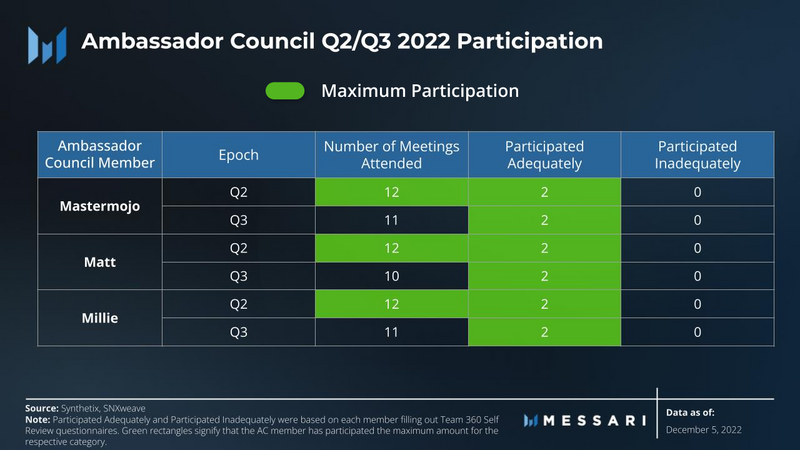
Treasury Council
The partnerships initiated by the Treasury Council are not required through a governance process and be formally voted on, i.e., Jump Crypto providing liquidity and Gauntlet becoming Synthetix’s risk partner. As per SIP 155, the Treasury Council has a broad mandate to do what is in the best interest of the Synthetix Treasury. This includes what is in the best interest of SNX, asset management, and risk management. Warwick has stressed the importance of the Treasury Council having the autonomy to be agile and act in the best interest of Synthetix, especially during a crisis. Thus, the Treasury Council does not have the same checks and balances as the Spartan Council or the other councils.
While the Treasury Council’s activities are more opaque than the other councils, the plan is for the Treasury Council members to complete the same Team 360 Self Review questionnaires the other councils participated in.
Core Contributor Committee
The Core Contributor Committee plays an important role in Synthetix becoming more decentralized; however, all Core Contributor Committee communications, votes, and operations are currently private. The Synthetix community has to blindly trust this committee to act in good faith due to the little transparency and verifiability of the committee’s actions. With the ethos of the DAO model being transparent in its communications, private communications feel like a step in the wrong direction.
Synthetix Governance Looking Forward
The announcement of Synthetix V3 created a buzz on Twitter in July 2022, sparking conversations regarding the future of the Synthetix protocol. Synthetix V3 outlines the long-term vision of permissionless asset creation, improved credit control, Liquidity-as-a-Service (LaaS), and a differentiated debt pool. At the time of writing, SIPs 300–312 are all currently in the draft phase, but these proposals aim to migrate Synthetix from V2.X to V3. The transition to V3 will likely be completed in early 2023. V3 will update many of the Synthetix smart contracts and improve Synthetix’s current technical and economic inefficiencies — thus improving the user experience across the Synthetix ecosystem.
Conclusion
Synthetix is one of the oldest DeFi protocols and is currently in a state of transition as it implements lessons from the DeFi sector into Synthetix V3. Synthetix’s overall focus is to survive and thrive in the long term. A clear example of this can be seen in the successful SIPs and SCCPs that balance user growth while also optimizing for increased revenue to build a sustainable protocol.
Although a few areas of Synthetix Governance could be improved, all the Synthetix Councils have been actively delivering value to the Synthetix protocol. They seem to be acting in good faith on behalf of the Synthetix community while actively trying to drive value back to the Synthetix ecosystem. The upcoming voting (and subsequent implementation) of all the Synthetix V3 SIPs (300–312) means the Synthetix Community should have a lot to look forward to in the new year.
Appendix
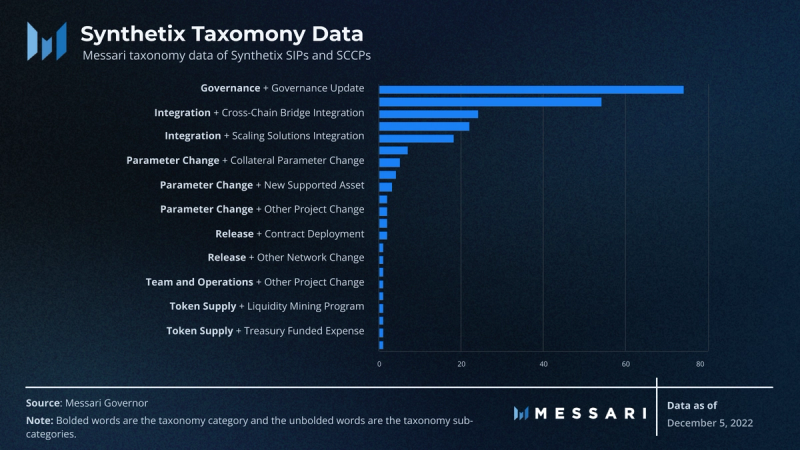
Let us know what you loved about the report, what may be missing, or share any other feedback by filling out this short form. All responses are subject to our Privacy Policy and Terms of Service.












